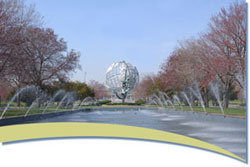
The Valley of Ashes and Waste Management in the 1920s
New
York, by virtue of its large concentrated population has always been a problem
as far as waste management. The
city’s traditional method of garbage disposal since the days when it was a
Dutch colony was to simply deposit waste in the streets.
The first concentrated efforts to solve the waste problems came in 1832.
Sometimes these efforts removed as much as two feet of garbage from the
city’s streets so that their surface was finally visible.
However, the city itself seemed to be opposed to any type of trash
collection, as private citizens repeatedly managed to block up the public sewers
through illegal dumping.
However, the situation started to become dangerous for residents, as
slums saw mortality rates for young children rise to fifty percent.
The situation was finally seriously looked at in 1896 with the
appointment of George E. Waring Jr. to the post of sanitation commissioner.
He instituted such “revolutionary changes as the separation of refuse
at the curb. He also reorganized
the department to make it more efficient. He
took a new approach for the use of the waste by selling it to industries that
could use it for raw material such as grease and fertilizer.
However,
during the years that followed, his attempts had increasingly little success.
A drop in the “value” of waste led to the mass usage of incineration
as a technique for disposal. Garbage
was placed in strategic locations where it would be transported an incinerator
facility, where it would be burned. However,
the incineration did leave some waste in itself, and this was generally stored
in open dumps. Perhaps the most
famous of these was the one located in Flushing Meadows Queens.
A dump that had such renown that it was used as a significant setting in The
Great Gatsby.
This dump eventually grew to be unfeasible in the borough of Queens, as
the population jumped to two million people, and the dump took up 330 acres of
land that were needed to support the population.
The city’s newly created parks department was headed by Robert Moses,
who claimed the area for the original purpose of usage in the World’s Fair
held in New York in 1939. After the
fair, the area’s renaissance continued. The
beach that was previously used as a landing for barges to dump their ash was
converted to Rockaway Beach and its boardwalk.
The famous Astoria Park Pool also opened in its vicinity.
It then experienced a minor regression until the 1960s, when Robert Moses
again played a part in the revitalization.
His corporation held a sequel to the 1939 World’s Fair in 1965, and two
years after this event, the land was officially turned over to the parks
commission.
Since the late 1960s, the area that was formerly a dump has really been a prime example of urban success. High profile athletic events such as the U.S. Open and diplomatic events such as the U.N. General Assembly have been held in this former dump. Shea Stadium, home of the New York Mets, is also located here, although it does say something that the Mets play in a former dump. The park currently hosts concerts and has recently installed turf soccer fields so New Yorkers can continue to enjoy it.

Shea Stadium, located in what once was the valley of Ashes.

A
modern view of the Flushing Meadows Dump.
Baker, Kevin. "Recycling in New York; The History of Ash Heaps" The New York Times, January 5, 2004.
Benepe, Adrian. Flushing Meadows Corona Park. Jan. 24, 2004. <http://flushingmeadowscoronapark.org/about_park>